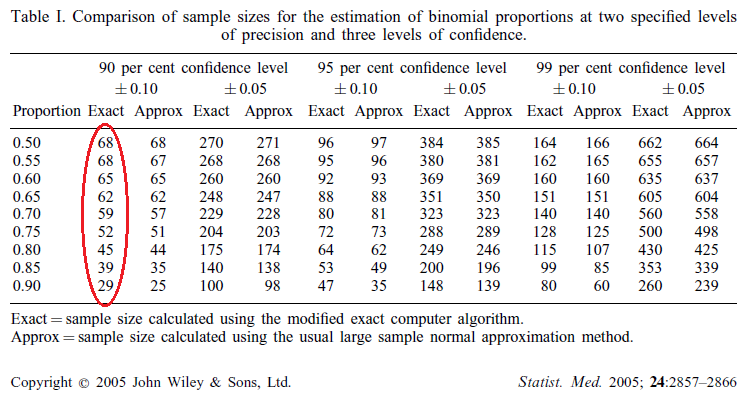I am interested in using the results from this paper (Modified exact sample size for a binomial proportion with special emphasis on diagnostic rest parameter estimation by Geoffrey Fosgate) to calculate sample sizes. There is an implementation of the algorithm used to calculate the sample size in R's binomSamSize package. I have checked the code used to calculate this and it seems to follow the paper exactly, but the results shown in the paper's results section do not seem to be reproducible. The sample sizes turn out to be too small.
The paper requires a subscription to be viewed in it's entirety, but here is a snippet to show how the sample size is calculated:
Here are the results I want to reproduce:

Here is the code I am using (lifted from the binomSamSize package):
ciss.midp <- function(p0, d, alpha, nMax = 1e+06){
pi.L <- p0 - d
pi.U <- p0 + d
if (pi.L < 0)
stop("p0 - d is below zero!")
if (pi.U > 1)
stop("p0 + d is above one!")
n <- floor(max(1/p0, 1/(1 - p0)))
done <- FALSE
while (!done & (n < nMax)) {
n <- n + 1
x <- round(p0 * n)
lhs2 <- 1/2 * dbinom(x, size = n, prob = pi.L) + 1/2 *
dbinom(x, size = n, prob = pi.U) +
pbinom(x, size = n, prob = pi.L, lower.tail = FALSE) +
pbinom(x - 1, size = n, prob = pi.U)
if (!is.na(lhs2)) {
done <- (lhs2 < alpha)
}
}
return(n)
}
What I end up getting to produce the circled column is this:
> sapply(seq(0.5, 0.9, 0.05), function(i) ciss.midp(p0=i, d=0.1, alpha=0.1))
[1] 68 67 65 61 57 50 42 34 23
PS: If there is anything else I can provide to make this easier to answer, please let me know in the comments.

